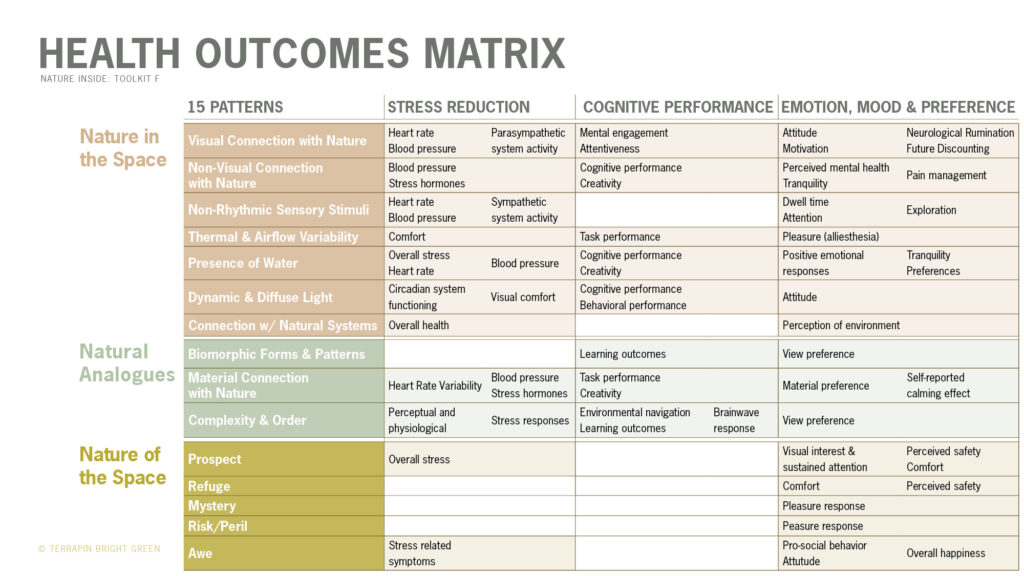As we embark on Phase 2 of the equitable engagement component of our project, consulting District users about streetscape and park amenities and programming, it seems important to revisit our experience with biophilic design and the consulting firm, Terrapin Bright Green.
Terrapin is a consulting firm that specializes in design, whole systems thinking, and research in biophilic design, bioinspired innovation, and ecological design. Founder, Bill Browning has consulted and worked on projects for Wal-Mart, the White House, the National Aquarium, Disney Hong Kong and the Pentagon. He was also involved in the launch of the New York Green Building Council and LEED building certification, which he says is one of the things he is most proud of.
Terrapin was hired to explore the opportunities for biophilic design in the Southwestern Medical District (SWMD) project by hosting workshops that gave a more in-depth look at biophilic design and to help guide the team. According to Terrapin, theorists, research scientists, and design practitioners have been working for decades to define aspects of nature that most impact our satisfaction with the built environment. Biophilic design can reduce stress, enhance creativity and clarity of thought, improve our well-being and expedite healing; as the world population continues to urbanize, these qualities are ever more important. Therefore, Terrapin came up with ‘14 Patterns of Biophilic Design’ (now 15) which articulates the relationships between nature, human biology and the design of the built environment so that we may experience the human benefits of biophilia in our design applications.
For SWMD, Terrapin identified four potential biophilic design goals with ideas for applications following the workshops, these include: positive perceptions of safety for all users, clear navigation and signaling, consideration of thermal comfort that supports routine use and enjoyment of outdoor amenities, and diverse options that enable multiple user groups to benefit from a single intervention (see the Terrapin Health Outcomes Matrix below).

For these design goals several themes were also suggested. Some of these include ‘Prospect Refuge Theory’, a term coined by human geographer, Jay Appleton in 1975, is the notion that we seek out opportunities to: perceive and acquire visual information, to explore environments, and find opportunities (prospect); and to seek out: shelter, protection, and environments where one can hide away (refuge) (landarchconcepts online). Design suggestions for this include having the presence of water for visual and auditory connection to nature. For example, the rendering of lavender in a walkway on the cover of this month’s newsletter represents the non-visual connection with nature; or stimuli that engender a deliberate and positive reference to nature, living systems and natural processes. Think about the effects of the calming scent of lavender plants.
For the third goal that addresses thermal comfort levels that support routine use and enjoyment of outdoor amenities, the consulting team suggested ‘fractal fluency’ and ‘forest bathing’. This suggests not only a material connection to nature, like the use of wood or tree ring patterns, leaf patterns embedded in the design of materials or in amenities; and forest bathing, like the thermal impact of tree canopy on a hot summer day. Considering that even one plant can improve a person’s happiness and help relieve fatigue or stress (Helphand, 2006), tree coverage at a busy intersection could have positive impacts for pedestrians crossing the street.
Additional opportunities and design interventions suggested by the consulting team include consideration of a thin or wide median and other stretches where there is no median at all; a median would offer some experiential benefits, primarily intermittent shade, a resting place for slower-paced travelers, and an opportunity for parents / caregivers to recompose children or gear before completing the cross. Further stating that a more positive driving experience will equate to a more positive pedestrian and cyclist experience (think again here about the calming effect of tree canopy, not only on pedestrian but drivers too).
Moreover, the team said that given the frequency and importance of crosswalks, amenities should be incorporated into the crosswalks. People are in cars, on bicycles and on foot; each will experience the corridor at different speeds and will require different types of biophilic interventions. Also, those engaging in meditative or internal fitness (yoga, meditation) will have different experiential (acoustic, spatial) requirements than those engaged in group/high energy fitness like a game of basketball.
Another interesting point that Terrapin made was to consider culture and upbringing during the process of design. In an urban environment, many users will not have been previously exposed to much nature, so a varying degree of density and clear navigation cues may be necessary to help ensure that everyone has a positive experience. Furthermore, there are a plethora of ‘nodes’ that emphasize engagement for children which can also incorporate elements for adults, be it through art, wit, humor, etc. (see several of these ‘nodes’ and opportunities for place-making below).
With thoughtful design elements in the park and along the corridor, and the input of everyone involved, from community leaders to hospital staff, it is these combined efforts that will usher in a sense of place, and a sense of belonging in the District; giving it a campus-like feel, and the intention of helping all District users to find points of relaxation, creativity and belonging.

References
Consultant website and reference for 15 biophilic design patterns: https://www.terrapinbrightgreen.com/
Prospect Refuge Definition: https://landarchconcepts.wordpress.com/what-is-prospect-refuge/
